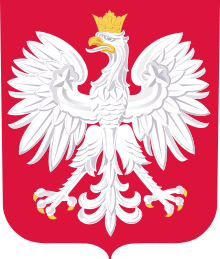Media of Poland
| Part of a series on the |
| Culture of Poland |
|---|
| People |
| Traditions |
|
Mythology and folklore |
| Cuisine |
| Festivals |
| Religion |
|
Music and performing arts |
| Sport |
|
The Media of Poland consist of several different types of communications media including television, radio, cinema, newspapers, magazines, and Internet. Many of the media are controlled by large for-profit corporations who reap revenue from advertising, subscriptions, and sale of copyrighted material.
Media and politics
During the communist regime in Poland the Stalinist press doctrine dominated and controlled Polish media.[1] This doctrine aimed at getting the support of people and making Polish people "Soviets".[1] The country instituted freedom of press since the fall of communism. However, public TV and radio are still politically controlled, via a state regulatory body called Krajowa Rada Radiofonii i Telewizji (The National Radio and Television Committee), which is similar to CRTC in Canada. It is said that both public and private media are not impartial, and used as means for political propaganda. Various irregularities have been exposed during the investigation by a special parliamentary committee into the Lew Rywin affair.
TV stations
TVP – public broadcaster
- TVP 1
- TVP 2
- TVP 3 (regional)
- TVP HD
- TVP Info (news and regional)
- TVP Polonia (for Poles abroad)
- TVP Kultura (cultural)
- TVP Seriale (drama)
- TVP Rozrywka (entertainment)
- TVP ABC (children's channel)
- TVP Sport
- TVP Historia (history)
- TVP Parlament
- Belsat (in Belarusian language)
Polsat – private
- Polsat
- Polsat News (24/7 news channel)
- Polsat News 2
- Polsat 2 International (or Poles abroad)
- Polsat Sport (sport channel)
- Polsat Sport Extra (sport channel)
- Polsat Sport News
- Polsat Cafe (health and beauty)
- Polsat Play (for men)
- Polsat Romans
- Polsat JimJam - for kids
- Polsat Crime & Investigation Network
- Polsat Film
- TV4
- TV6
Grupa ITI (International Trading and Investments Holdings SA Luxembourg)
- TVN
- TVN 7
- TVN24 (24/7 news channel)
- TVN24 Biznes i Świat
- TVN Style (channel aimed at women)
- TVN Turbo (for men)
- TVN Meteo Activ (weather)
- TVN Fabuła
- iTVN (for Poles abroad)
- TTV*
- Mango24 (shopping)
*TTV belongs to Stavka (51% - TVN, 49% - Besta Film)
Polcast Television
Minor players and joint-ventures:
- Discovery Historia (history and documentaries)
- TV Puls
- TV Trwam (catholic channel; owner Lux Veritatis Foundation)
- iTV (interactive TV)
- 4fun.tv (interactive music; 4fun Media S.A. owned by Nova Holding Ltd., London)
- many local city and community cable stations
Many major players are also present on the market, among them: Canal+ Polska, Canal+ Sport, Canal+ Film, Canal+ Sport2, HBO, HBO2, EuroSport, EuroSport2, Discovery Channel, Discovery Travel & Living, Discovery Science, Discovery World, MTV Poland, VIVA Poland, VH1 Poland
Digital TV platforms (all private)
- nC+ (owned by Canal Plus Cyfrowy/ITI Group)
- Cyfrowy Polsat (owned by Polsat Cyfrowy stock company)
Radio stations
Polskie Radio (public broadcaster)
- Program 1 (aka Jedynka)
- Program 2 (aka Dwójka)
- Program 3 (aka Trójka)
- Program 4 (aka Czwórka)
- Radio Parlament
- Polskie Radio dla Zagranicy (Polish Radio External Service)
- 17 regional stations of Polskie Radio
Privately owned stations
Broker FM group:
- RMF FM (nationwide)
- RMF Classic (classical music)
- RMF MAXXX (dance and pop music)
Eurozet group:
- Radio Zet (nationwide)
- Chilli Zet (chillout and jazz music)
- Antyradio (rock music)
- Planeta FM (dance and club music)
- Radio Plus (soft pop music)
Agora group:
Time group:
- Radio Eska (pop and dance music)
- Eska Rock (rock music)
- VOX FM (oldies)
- Radio WAWA (polish music)
other:
- Radio Maryja (religious, conservative, political)
- local radio stations
Polish radio stations in other countries
- Anglo-Polish Radio ORLA.fm http://www.orla.fm
- Polskie Radio Londyn
Press (all private)
Daily papers
- Gazeta Wyborcza (centrist) http://www.wyborcza.pl
- Rzeczpospolita (centre-right) http://www.rp.pl
- Dziennik Gazeta Prawna (centrist) http://www.dziennik.pl
- Polska (centrist; edited in cooperation with the British daily The Times) http://polskatimes.pl
- Gazeta Polska Codziennie (right-wing) http://www.gpcodziennie.pl
- Fakt (tabloid) http://www.efakt.pl
- Super Express (tabloid) http://www.se.com.pl
- Nasz Dziennik (catholic, right-wing) http://www.naszdziennik.pl
Weekly magazines
- Polityka (centre-left) http://www.polityka.pl
- Newsweek Polska (Polish edition of Newsweek, centrist to left-wing) http://www.newsweek.pl
- Wprost (centrist to right) http://www.wprost.pl
- Przekrój (left-wing) http://www.przekroj.pl
- Przegląd (left-wing) http://www.przeglad.com.pl
- NIE (left-wing) http://www.nie.com.pl
- Gazeta Polska (right-wing) http://www.gazetapolska.pl
- Najwyższy Czas! (conservative) http://www.nczas.com
- Tygodnik Powszechny (Catholic socio-cultural weekly) http://tygodnik.onet.pl
- Niedziela (Catholic weekly) http://www.niedziela.pl/
- Gość Niedzielny (Catholic weekly) http://goscniedzielny.wiara.pl/
- Angora (left-wing Polish and world press review) http://www.angora.pl
- Forum (world press review, rather centrist to left-wing)
Internet
- Top-level domain: .pl
- Internet users: 25.0 million users, 21st in the world; 65.0% of the population, 54th in the world (2012).[2][3]
- Fixed broadband: 6.4 million subscriptions, 17th in the world; 16.6% of the population, 54th in the world (2012).[2][4]
- Wireless broadband: 18.9 million subscriptions, 16th in the world; 49.3% of the population, 33rd in the world (2012).[5]
- Internet hosts: 13.3 million hosts, 12th in the world (2012).[6]
See also
References
- 1 2 Sasinska-Klas, Teresa (1994). "The transition of mass media in Poland: The road to liberalization". EJC/REC. 4 (1). Retrieved 6 October 2013.
- 1 2 Calculated using penetration rate and population data from "Countries and Areas Ranked by Population: 2012", Population data, International Programs, U.S. Census Bureau, retrieved 26 June 2013
- ↑ "Percentage of Individuals using the Internet 2000-2012", International Telecommunications Union (Geneva), June 2013, retrieved 22 June 2013
- ↑ "Fixed (wired)-broadband subscriptions per 100 inhabitants 2012", Dynamic Report, ITU ITC EYE, International Telecommunication Union. Retrieved on 29 June 2013.
- ↑ "Active mobile-broadband subscriptions per 100 inhabitants 2012", Dynamic Report, ITU ITC EYE, International Telecommunication Union. Retrieved on 29 June 2013.
- ↑ "Internet hosts", World Factbook, U.S. Central Intelligence Agency, 2012. Retrieved 17 June 2013.
